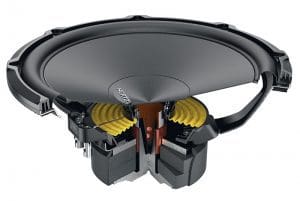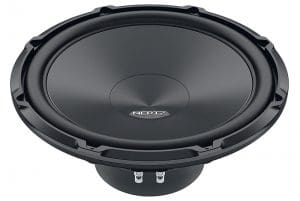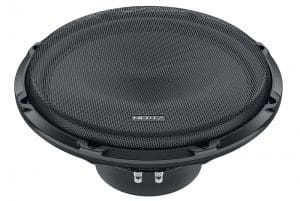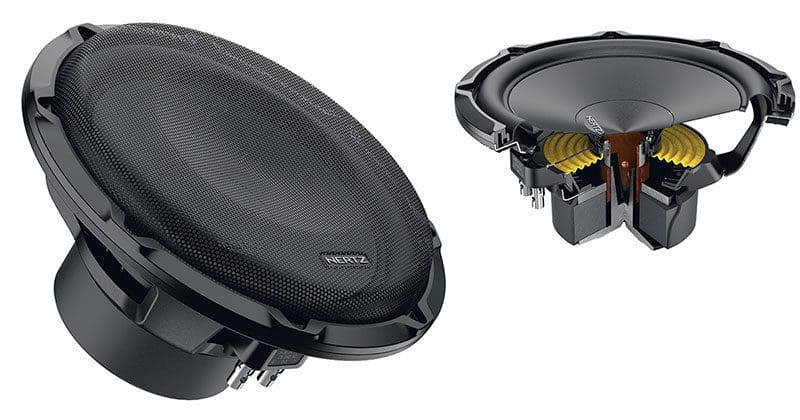As a continuation of our look at the Hertz Cento Series, we are going to delve into the features of the new Cento Subwoofers. Available in 10- and 12-inch sizes with either two- or four-ohm voice coil configurations, the Cento subwoofers are a perfect example of trickle-down technology providing amazing value and performance for car audio enthusiasts.
Hertz Cento Subwoofer Physical Features
 The Cento subwoofers are based on a rigid four-spoke basket. Vents in the base of each spoke allow hot air to escape from underneath the spider to provide voice coil cooling. A flat (not cupped) spider is mounted on a plastic spacer at the base of the basket. Spring-loaded wire terminals capable of accepting 8AWG wire are molded into an extension off the side of the spider spacer ring. Additional cooling is provided by vertical vents in the plastic reinforcement ring that is used to attach the voice coil former to the spider and the cone. This ring dramatically increases the glue contact area and helps to ensure each component is aligned perfectly at this crucial triple joint.
The Cento subwoofers are based on a rigid four-spoke basket. Vents in the base of each spoke allow hot air to escape from underneath the spider to provide voice coil cooling. A flat (not cupped) spider is mounted on a plastic spacer at the base of the basket. Spring-loaded wire terminals capable of accepting 8AWG wire are molded into an extension off the side of the spider spacer ring. Additional cooling is provided by vertical vents in the plastic reinforcement ring that is used to attach the voice coil former to the spider and the cone. This ring dramatically increases the glue contact area and helps to ensure each component is aligned perfectly at this crucial triple joint.
The glass fiber voice coil former has a diameter of 35 mm (1.38 inches) and serves as a home to a six-layer copper winding. The result is 300 watts of continuous power handling on the 10-inch CS 250 S2 and C2 250 S4 subwoofers and 350 watts on the 12-inch CS 300 S2 and S4 models. Based on the height of the voice coil windings and the thickness of the top plate, the Hertz Cento subwoofers have an X-max specification of 12.5 mm (one-way).
 A one-piece ferrite magnet at the base of the speaker provides magnetic flux. There is no cooling vent in the T-yoke of the Cento subwoofers, so your installer can butt them right up against the back of an enclosure without fear of affecting their performance or reliability. Speaking of mounting requirements, the 10-inch subs require a mounting depth of 4.53 inches and the 12-inch models need 5.12 inches.
A one-piece ferrite magnet at the base of the speaker provides magnetic flux. There is no cooling vent in the T-yoke of the Cento subwoofers, so your installer can butt them right up against the back of an enclosure without fear of affecting their performance or reliability. Speaking of mounting requirements, the 10-inch subs require a mounting depth of 4.53 inches and the 12-inch models need 5.12 inches.
The cone and dust cap on the Cento subwoofers are made from polypropylene and are attached to the outer edge of the basket using a rubber surround. An ABS plastic trim and mounting ring around the perimeter of the drive provides a clean and classy appearance once installed. Hertz offers optional protective mesh grilles with part numbers CG 250 and CG 300 to help keep the subs looking like new.
Enclosure Requirements
 Hertz suggests that the CS 250 S2 and S4 will work in enclosures as small as 0.57 cubic feet and the CS 300 S2 and CS 300 S4 will work in a 1-cubic-foot enclosure. The 10-inch designs result in a system F3 of 55 Hz, and the 12-inch designs have an F3 of just under 50 Hz. For both applications, Hertz recommends implementing an infrasonic high-pass filter at 15 Hz with a slope of 24 dB/octave to prevent damage due to high excursion levels. Based on a quick look at the specifications, your system designer can use these subwoofers in a vented enclosure to provide about 4 dB more output across the board in exchange for increased enclosure volume.
Hertz suggests that the CS 250 S2 and S4 will work in enclosures as small as 0.57 cubic feet and the CS 300 S2 and CS 300 S4 will work in a 1-cubic-foot enclosure. The 10-inch designs result in a system F3 of 55 Hz, and the 12-inch designs have an F3 of just under 50 Hz. For both applications, Hertz recommends implementing an infrasonic high-pass filter at 15 Hz with a slope of 24 dB/octave to prevent damage due to high excursion levels. Based on a quick look at the specifications, your system designer can use these subwoofers in a vented enclosure to provide about 4 dB more output across the board in exchange for increased enclosure volume.
Amazing Bass and Great Value
A single Cento subwoofer is a perfect match for the DPower1 monoblock amplifier, or you could match a pair of them to the HCP 1D monoblock. If you’re in the market for a subwoofer that won’t break the bank but provides low-frequency performance from relatively compact enclosure designs, drop by your local authorized Hertz retailer and ask for a demonstration of the new Cento subwoofers.


